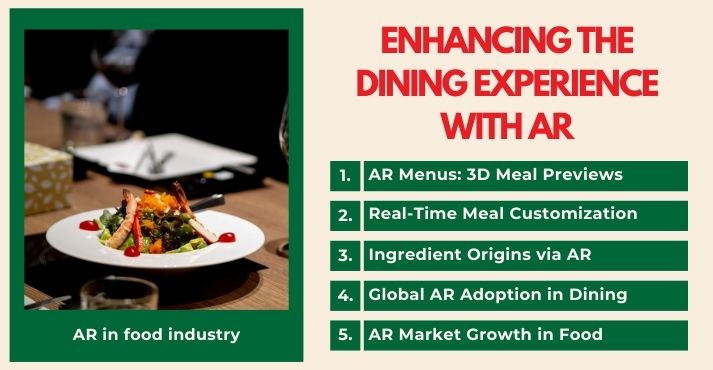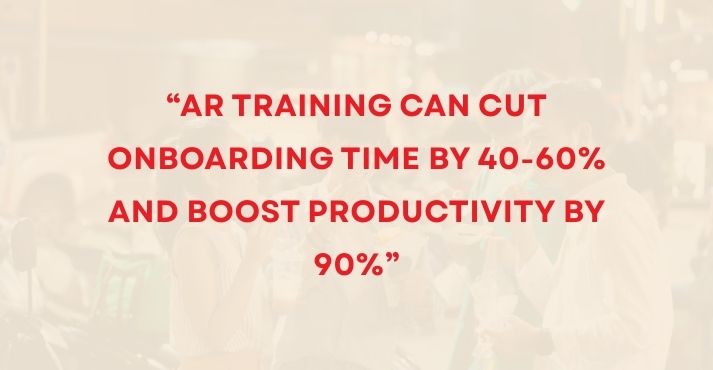Augmented reality (AR) is significantly impacting the food sector, changing how businesses and consumers interact with products and services.
Unlike virtual reality, which immerses users in a completely digital world, augmented reality enhances the real world by overlaying digital elements.
In the food space, AR opens up new ways to improve customer experiences, streamline operations, and develop innovative marketing strategies.
For example, interactive AR menus enable customers to view dishes before ordering, while packaging can provide additional product information. AR also helps train kitchen staff and boost consumer engagement.
In 2025, the market for augmented reality in food technology is experiencing rapid growth, with widespread adoption across the United States, Europe, Japan, and Singapore.
As the technology advances, AR’s influence on the food and beverage industry is expected to increase.
Enhancing the Dining Experience with AR

Augmented reality opens new avenues in the food industry, changing how customers interact with meals while enhancing engagement and elevating the dining experience.
AR menus are among the most exciting innovations, with platforms like Rock Paper Reality and Kabaq leading the way in showcasing 3D dishes that diners can explore before placing an order.
This virtual food experience gives customers a clearer sense of what they’re about to enjoy, making the selection process more engaging and less guesswork-driven.
Additionally, restaurants now use AR overlays that let customers personalize their meals visually. With support from platforms like BrandXR, diners can toggle ingredients, see visual changes in real time, and customize their dish before it hits the table.
This enhances the overall customer experience, helping restaurants stand out in a competitive market.
AR is also changing how restaurants share the origins of their ingredients. With scannable QR codes, diners can access overlays that reveal where and how ingredients were sourced.
AR is no longer just an idea across countries like the United States, Singapore, and Japan, but is already part of how some restaurants operate. Singapore’s eateries offer virtual tastings, while US brands integrate AR to connect meals with origin stories and nutritional data.
As of 2024, the global augmented reality market was valued at USD 93.67 billion, and it’s expected to reach USD 140.34 billion in 2025, surging to USD 1,716.37 billion by 2032.
This massive growth signals the increasing role of augmented reality in the food and other industries.
Still, barriers remain. Not all customers have compatible devices or the digital fluency to navigate AR features. Implementation costs can also challenge smaller businesses.
However, benefits like richer engagement, streamlined ordering, and greater transparency make AR a powerful asset in modern dining.
AR in Food Marketing & Product Packaging
Augmented reality is changing the way food brands engage with consumers through packaging, turning it into an interactive experience.
Emmi’s AR-enabled packaging for Good Day milk drinks is a great example. In collaboration with Tetra Pak and Appetite Creative, Emmi lets consumers scan the packaging to view animations and get nutritional details.
This offers a fun and informative way to connect with the product, providing the transparency that consumers expect nowadays.
AR is also helping food products stand out in crowded retail spaces. A recent study revealed that 63% of consumers find AR packaging more memorable than traditional designs, giving brands an edge when competing for attention.
With the AR advertising market projected to reach $5.8 billion in 2025, more brands will adopt this technology to grab consumers’ attention.
In addition to boosting visibility, AR is helping brands communicate their sustainability efforts. Through scannable QR codes, customers can learn about the sourcing of ingredients and the environmental impact of their purchases.
This kind of transparency is becoming an important part of the sustainable packaging movement.
Looking ahead at food tech trends for 2025, we can expect more interactive food labels to become a common feature. Major brands like Nestlé and PepsiCo are already incorporating augmented reality into their packaging strategies.
PepsiCo, for instance, launched an AR-enabled campaign during a global soccer promotion, where limited-edition cans featured QR codes that led to interactive digital experiences with well-known football players.
It was a smart way to turn everyday packaging into a more engaging and memorable part of the customer experience.
AR food packaging is more than a trend. It’s changing how brands connect with shoppers. With interactive food labeling, AR adds transparency and makes food shopping more engaging and meaningful.
AR in Staff Training and Back-of-House Operations

Augmented reality (AR) is making waves in staff training, especially in Quick Service Restaurants (QSRs) and franchise kitchens.
By offering virtual simulations, AR is changing the way new chefs, waitstaff, and food handlers are trained, providing them with hands-on experience without the risk of making mistakes during actual service.
For example, AR training tools can guide new kitchen staff through food prep processes, show proper cleaning procedures, or help them familiarize themselves with kitchen layouts. This allows employees to learn efficiently without needing long, in-person training sessions.
In fact, AR training solutions have been shown to cut onboarding time by 40-60%, making it easier for businesses to get new hires up to speed quickly.
Additionally, these systems improve worker productivity by up to 90%, as employees can learn and practice in a more interactive, immersive environment.
AR can also help reduce human error by providing real-time, step-by-step instructions and visual cues, ensuring that each task is completed accurately.
For example, AR chef training programs allow aspiring cooks to see exact measurements or cooking techniques displayed over their ingredients, enhancing precision in the kitchen.
One exciting development is AR-assisted supply chain traceability. This technology enables restaurants to track ingredients from farm to table, giving staff access to vital information about the sourcing and quality of ingredients in real time.
It ensures higher accountability, especially regarding food safety and quality assurance inspections.
Several QSRs are already implementing AR in their training and operational procedures. For instance, Domino’s Pizza implemented AR technology in its training programs to enhance staff performance and operational efficiency.
One notable example is the Pizza Maker course, a training strategy that used simulations and gamification to engage, assess, and reward employees during the learning experience.
By including elements encouraging employees to improve past scores, the games helped new employees master the menu sooner and make more accurate pizzas faster, thus decreasing onboarding time.
Similarly, other franchise kitchens are integrating AR into their daily operations, making it easier for staff to follow standardized procedures, regardless of location.
AR will become an important part of staff training and back-of-house operations as it advances, making processes smoother and boosting efficiency in the food and service industry.
Future Trends & Emerging Use Cases in 2025 and Beyond

Augmented reality (AR) is poised to become even more important in the food industry. As technology improves and more businesses adopt it, AR will change how restaurants run and customers enjoy dining experiences.
Let’s look at some of the major trends and emerging uses of AR in the years to come:
Personalized Dining Experiences with AR
As consumers increasingly seek tailored experiences, AR is stepping in to offer personalized dining options. By integrating AR with consumer data, restaurants can create immersive, customized experiences based on a diner’s preferences, dietary needs, or past visits.
Imagine entering a restaurant where your menu instantly adapts to your likes, dislikes, and health preferences. Whether you prefer gluten-free dishes or want to explore new flavors, AR can help curate a dining experience like never before.
The Growing Trend of Virtual Tastings
One exciting trend in the future of dining is the rise of “virtual tastings” enabled by AR technology. Using tools like e-Taste, customers can experience flavors and textures virtually before eating.
This technology allows food lovers to take part in tastings from the comfort of their homes or try new culinary offerings from chefs worldwide. As more people look for fun and engaging experiences, virtual tastings will likely become a regular part of the food industry.
AR Smart Glasses: Revolutionizing Restaurants and Kitchens
AR smart glasses are becoming more common in front-of-house and back-of-house restaurant operations.
These glasses allow restaurant staff to access real-time data, step-by-step cooking instructions, or customer preferences without consulting physical menus or devices.
For kitchen staff, AR can guide them through complex prep tasks or provide reminders on ingredient quantities.
In front-of-house operations, waitstaff can quickly check tables, orders, or even guide customers to their seats. This technology can streamline workflows, improve efficiency, and enhance the customer experience.
Overcoming Cost, Infrastructure, and Adoption Barriers
While AR holds immense potential, there are challenges to overcome before it becomes mainstream in the food industry. One of the primary obstacles is cost.
Implementing AR systems, whether for staff training, personalized dining experiences, or kitchen operations, requires significant investment in hardware, software, and infrastructure.
Additionally, smaller restaurants may face difficulties in adopting this technology due to limited resources or the need for specialized training.
Getting past these challenges is important for AR to grow. Tools like affordable apps and cloud systems can help make that happen.
How Consumer Use of AR Will Shape the Future of Dining
As AR technology becomes more accessible to consumers, its influence on the dining industry will continue to grow. In the future, consumers will be able to use their smartphones or AR headsets to interact with menus, order food, or even learn more about the origins of their meal.
This widespread use will enhance the dining experience with more immersive, engaging, and personalized interactions between restaurants and customers.
The future of dining will be more dynamic, with AR offering endless possibilities for enhancing operational efficiency and customer satisfaction.
Conclusion – A Multi-Sensory Future for Food
Augmented reality (AR) creates a multi-sensory future for the food industry. It’s improving marketing, operations, and how customers experience food, making packaging more interactive, training more effective, and dining more engaging.
As we’ve seen, AR allows food brands to engage customers more meaningfully. Whether it’s by offering personalized dining experiences, creating virtual tastings, or enhancing kitchen operations, the potential for AR to enrich both the back and front of house is immense.
AR also helps brands improve visibility, work more efficiently, and connect better with customers. As more companies try this technology, the opportunities keep growing.
Food businesses and tech partners should team up to test AR ideas and unlock new ways to experience food. The future isn’t just about taste but combining flavor, tech, and interaction for a richer, more engaging experience.





























